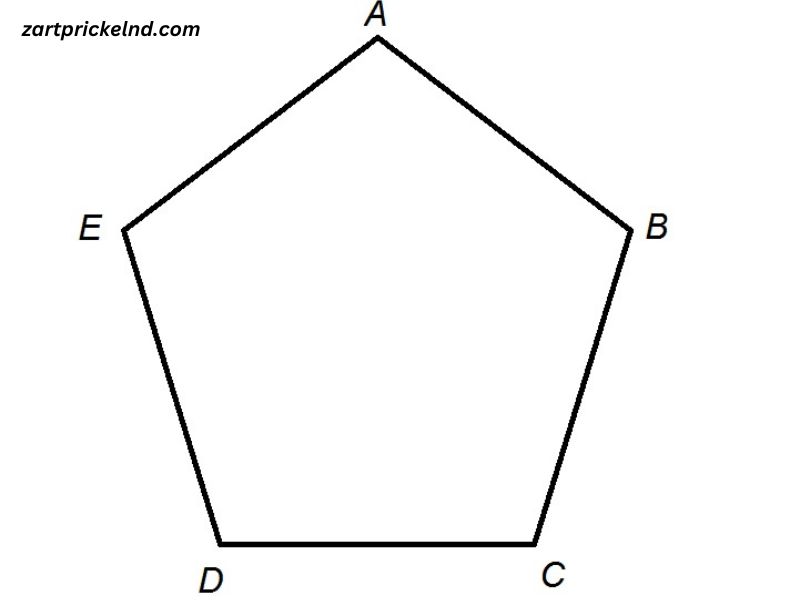When it comes to shapes and their properties, geometry provides us with an intriguing world to explore. One of the most commonly discussed shapes is the pentagon. Whether you’re studying geometry in school or simply curious about the world of shapes, the question “How many sides does a pentagon have?” is one that often comes up. The answer, however, is more than just a simple number—it opens the door to a variety of interesting facts about polygons, the properties of pentagons, and their significance in both mathematical and real-world contexts.
In this article, we will explore how many sides a pentagon has, delve into the characteristics of pentagons, their types, and how they appear in the world around us. By the end, you’ll have a deeper understanding of the pentagon and its place in geometry.
Understanding the Basics of a Polygon
Before diving into the specifics of a pentagon, it’s important to first understand what a polygon is. A polygon is a two-dimensional geometric figure that is made up of straight lines that are connected end-to-end to form a closed shape. The simplest type of polygon is the triangle, which has three sides. The number of sides in a polygon determines its classification:
- Triangle: 3 sides
- Quadrilateral: 4 sides
- Pentagon: 5 sides
- Hexagon: 6 sides
- Heptagon: 7 sides
- Octagon: 8 sides
- and so on.
So, when you ask, “How many sides does a pentagon have?” the answer is straightforward: 5 sides.
The Shape and Properties of a Pentagon
A pentagon is a five-sided polygon. The key properties of a pentagon include:
- Five Sides: As discussed, a pentagon has five straight edges, which make up its perimeter.
- Five Angles: The internal angles of a pentagon add up to 540 degrees. If the pentagon is regular (meaning all sides and angles are equal), each interior angle will be 108 degrees.
- Symmetry: A regular pentagon has five lines of symmetry, which are drawn through the vertices (corners) of the pentagon and its center.
- Diagonals: A regular pentagon has five diagonals, which are lines drawn between non-adjacent vertices. These diagonals intersect each other in a unique way, forming smaller internal pentagons and star-like shapes.
Types of Pentagons
While the basic definition of a pentagon refers to any five-sided polygon, there are two primary types of pentagons:
1. Regular Pentagon
A regular pentagon is a polygon where all sides and all interior angles are equal. In a regular pentagon:
- All five sides have the same length.
- All five interior angles measure 108 degrees.
- It has five lines of symmetry.
The regular pentagon is often studied in geometry because of its symmetry and unique properties. It is also frequently found in art, design, and nature. For example, the star shape known as the pentagram is created by connecting the non-adjacent vertices of a regular pentagon.
2. Irregular Pentagon
An irregular pentagon is a five-sided polygon where the sides and angles are not all equal. This means the length of the sides can vary, and the interior angles may not all measure 108 degrees. Irregular pentagons do not have the same level of symmetry as regular pentagons, and their diagonals may not intersect in the same way as those of a regular pentagon.
An irregular pentagon can have any combination of side lengths and angles as long as it satisfies the condition of having five sides. In many practical applications, irregular pentagons are more commonly encountered than regular ones.
How to Calculate the Interior Angles of a Pentagon
The sum of the interior angles of any polygon can be calculated using the formula:
Sum of interior angles=(n−2)×180∘\text{Sum of interior angles} = (n – 2) \times 180^\circ
Where n is the number of sides of the polygon. For a pentagon, where n = 5:
Sum of interior angles=(5−2)×180∘=3×180∘=540∘\text{Sum of interior angles} = (5 – 2) \times 180^\circ = 3 \times 180^\circ = 540^\circ
This means that the sum of the interior angles of a pentagon is always 540 degrees. If the pentagon is regular, each of its five interior angles will measure:
540∘5=108∘\frac{540^\circ}{5} = 108^\circ
This formula helps us understand the geometric properties of the pentagon in more detail.
Real-World Applications of Pentagons
Although the pentagon is a basic geometric shape, it appears in many real-world scenarios and is used in various fields, from architecture to art. Here are some examples of how pentagons are found in the world around us:
1. Architecture and Design
The regular pentagon is often used in architectural designs, especially in the construction of decorative elements. The Pentagon building in Arlington, Virginia, one of the most famous buildings in the United States, is a large-scale example of a pentagonal structure. Its unique shape is not only visually striking but also offers practical benefits in terms of space efficiency and organization.
2. Nature
While pentagons are not as common in nature as other shapes like circles or triangles, they can still be found. For example, certain flower petals or starfish can exhibit pentagonal symmetry, with five distinct “arms” or segments radiating from a central point. This type of symmetry is often referred to as pentamerism and is found in various organisms, particularly in marine life.
3. Art and Symbolism
The pentagon has been used symbolically throughout history, especially in ancient cultures. For instance, the pentagram, a five-pointed star formed by connecting the non-adjacent vertices of a regular pentagon, has been a symbol of magic, mysticism, and protection in various cultures. The five points of the pentagram are often thought to represent the elements: earth, air, fire, water, and spirit.
4. Mathematics and Geometry
In mathematics, the study of polygons, including pentagons, is crucial in understanding the properties of shapes and their relationships. Regular pentagons, with their symmetry and unique angles, are often studied in geometry and trigonometry. The angles and diagonals of a pentagon also appear in many mathematical problems and proofs.
Conclusion
To answer the simple question, “How many sides does a pentagon have?”—a pentagon has five sides. However, this simple fact opens up a world of exploration in geometry, art, nature, and design. Whether you’re learning about polygons in school, designing a building, or studying natural patterns, understanding the properties of pentagons provides valuable insights into the world around us.
In this article, we’ve explored the characteristics of pentagons, including the difference between regular and irregular pentagons, the calculation of their interior angles, and their real-world applications. The pentagon is much more than just a shape with five sides; it is a symbol of symmetry, balance, and beauty that is deeply woven into both the natural and man-made worlds.
So the next time you encounter a pentagon, whether in a math problem or in a piece of art, you’ll know just how many sides it has and why that number is so significant!



